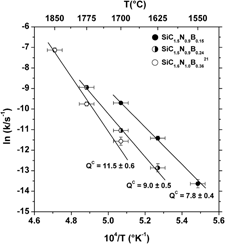Crossref Citations
This article has been cited by the following publications. This list is generated based on data provided by
Crossref.
Zhang, Pengfei
Jia, Dechang
Yang, Zhihua
Duan, Xiaoming
and
Zhou, Yu
2012.
Progress of a novel non-oxide Si-B-C-N ceramic and its matrix composites.
Journal of Advanced Ceramics,
Vol. 1,
Issue. 3,
p.
157.
Schurz, Fanny
and
Jansen, Martin
2012.
Influence of methyl‐modified silyl groups on the properties of polymers and Si/B/N/C ceramics derived from N‐silylated borazine derivatives.
Applied Organometallic Chemistry,
Vol. 26,
Issue. 9,
p.
483.
Tavakoli, Amir H.
Golczewski, Jerzy A.
Bill, Joachim
and
Navrotsky, Alexandra
2012.
Effect of boron on the thermodynamic stability of amorphous polymer-derived Si (B )C N ceramics.
Acta Materialia,
Vol. 60,
Issue. 11,
p.
4514.
Zhang, Pengfei
Jia, Dechang
Yang, Zhihua
Duan, Xiaoming
and
Zhou, Yu
2012.
Crystallization and microstructural evolution process from the mechanically alloyed amorphous SiBCN powder to the hot-pressed nano SiC/BN(C) ceramic.
Journal of Materials Science,
Vol. 47,
Issue. 20,
p.
7291.
Ionescu, Emanuel
Mera, Gabriela
and
Riedel, Ralf
2013.
MAX Phases and Ultra-High Temperature Ceramics for Extreme Environments.
p.
203.
Peng, YuQing
Han, KeQing
Zhao, Xi
and
Yu, MuHuo
2014.
Large-scale preparation of SiBN ceramic fibres from a single source precursor.
Ceramics International,
Vol. 40,
Issue. 3,
p.
4797.
Zhou, Cong
Min, Hao
Yang, Le
Chen, Meiyu
Wen, Qingbo
and
Yu, Zhaoju
2014.
Dimethylaminoborane-modified copolysilazane as a novel precursor for high-temperature resistant SiBCN ceramics.
Journal of the European Ceramic Society,
Vol. 34,
Issue. 15,
p.
3579.
Ionescu, Emanuel
Mera, Gabriela
and
Riedel, Ralf
2014.
Nanotechnology.
p.
1108.
Mera, Gabriela
Gallei, Markus
Bernard, Samuel
and
Ionescu, Emanuel
2015.
Ceramic Nanocomposites from Tailor-Made Preceramic Polymers.
Nanomaterials,
Vol. 5,
Issue. 2,
p.
468.
Kousaalya, Adhimoolam Bakthavachalam
Kumar, Ravi
and
Sridhar, B.T.N.
2015.
Thermal conductivity of precursor derived Si–B–C–N ceramic foams using Metroxylon sagu as sacrificial template.
Ceramics International,
Vol. 41,
Issue. 1,
p.
1163.
TAMAYO, Aitana
PEÑA-ALONSO, Raquel
MAZO, Maria Alejandra
RUBIO, Fausto
and
RUBIO, Juan
2016.
Combined pyrolysis-ammonolysis treatment to retain C during nitridation of SiBOCN ceramics.
Journal of the Ceramic Society of Japan,
Vol. 124,
Issue. 10,
p.
996.
Yuan, Jia
Li, Duan
Johanns, Kurt E.
Fasel, Claudia
Durst, Karsten
Kleebe, Hans-Joachim
Shen, Zhijian
Riedel, Ralf
and
Ionescu, Emanuel
2017.
Preparation of dense SiHf(B)CN-based ceramic nanocomposites via rapid spark plasma sintering.
Journal of the European Ceramic Society,
Vol. 37,
Issue. 16,
p.
5157.
Li, Daxin
Li, Qian
Yuan, Jingkun
Yang, Zhihua
Jia, Dechang
Cai, Delong
Wang, Shengjin
Zhou, Yu
Yu, Dongli
and
Tian, Yongjun
2018.
Effects of high pressure on the low-temperature sintering of dense amorphous SiBCN monoliths.
Journal of the European Ceramic Society,
Vol. 38,
Issue. 11,
p.
3777.
Li, Daxin
Yang, Zhihua
Jia, Dechang
Duan, Xiaoming
Zhou, Yu
Yu, Dongli
Tian, Yongjun
Wang, Zihuan
and
Liu, Yinglong
2018.
Role of boron addition on phase composition, microstructural evolution and mechanical properties of nanocrystalline SiBCN monoliths.
Journal of the European Ceramic Society,
Vol. 38,
Issue. 4,
p.
1179.
Viard, Antoine
Fonblanc, Diane
Lopez‐Ferber, David
Schmidt, Marion
Lale, Abhijeet
Durif, Charlotte
Balestrat, Maxime
Rossignol, Fabrice
Weinmann, Markus
Riedel, Ralf
and
Bernard, Samuel
2018.
Polymer Derived Si–B–C–N Ceramics: 30 Years of Research.
Advanced Engineering Materials,
Vol. 20,
Issue. 10,
Zhang, Peng Fei
Jia, De Chang
Yang, Bin
and
Wang, Guang Xin
2018.
A Mechanically-Alloyed Amorphous 2Si-B-3C-N Ceramic with a Crystallization Temperature up to 1800°C.
Solid State Phenomena,
Vol. 281,
Issue. ,
p.
323.
Jia, Dechang
Liang, Bin
Yang, Zhihua
and
Zhou, Yu
2018.
Metastable Si-B-C-N ceramics and their matrix composites developed by inorganic route based on mechanical alloying: Fabrication, microstructures, properties and their relevant basic scientific issues.
Progress in Materials Science,
Vol. 98,
Issue. ,
p.
1.
Li, Daxin
Yang, Zhihua
Jia, Dechang
Duan, Xiaoming
Cai, Delong
Wang, Shengjin
Yuan, Jingkun
Zhou, Yu
Yu, Dongli
and
Tian, Yongjun
2019.
High-temperature oxidation resistance of dense amorphous boron-rich SiBCN monoliths.
Corrosion Science,
Vol. 157,
Issue. ,
p.
312.
Yang, Zhihua
Li, Daxin
Zhao, Yang
Yang miao
Rao, Jiancun
Cai, Delong
Duan, Xiaoming
He, Peigang
Jia, Dechang
and
Zhou, Yu
2019.
In situ ZrC/Si-B-C-N monoliths prepared by sol-gel and reactive hot-pressing: Processing, microstructure, mechanical properties and oxidation behavior.
Journal of Alloys and Compounds,
Vol. 811,
Issue. ,
p.
151687.
Dwivedi, Sushmita
Badole, Manish
Gangwar, Kaushal
and
Kumar, Sunil
2021.
Relaxation processes and conduction behaviour in PVDF-TrFE and KNN-based composites.
Polymer,
Vol. 232,
Issue. ,
p.
124164.
